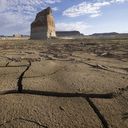States face unprecedented water cuts under Biden admin Colorado River crisis plan

U.S. officials released a set of proposals Tuesday for distributing cuts from the Colorado River — including one that would break from precedent by evenly assigning reductions among lower basin states, forcing users in California to shoulder more of the load.
Driving the news: The proposals would amend 2007 guidelines that govern cuts in the event of a shortage as climate change and other factors threaten the river that provides drinking water to 40 million people in seven states and 30 tribal nations.
- The U.S. Bureau of Reclamation released a draft supplemental environmental impact statement (SEIS) to potentially revise operations at the Hoover and Glen Canyon dams. Those dams created Lakes Mead and Powell — key reservoirs for the drought-stricken Colorado River.
- The bureau's proposals would govern releases from the two dams starting in 2024.
The big picture: The Colorado River Basin is in the midst of a 23-year drought that ranks as the region's worst in 1,200 years.
- The drought has already triggered cuts to the Central Arizona Project's (CAP) water allocation.
- The cuts could also impact tourism in popular travel destinations like Las Vegas, which gets 90% of its water from the river, per CNN.
Threat level: The river's flow is expected to fall 10-30% by 2050 due to climate change.
Details: The Biden administration's plan includes three options for apportioning cuts that would save nearly 2.1 million acre-feet of water, including previously agreed to cuts, which would be more than 15% of the river's total flow.
- In addition to previously established cutbacks, the proposals would reduce river use by 500,000-600,000 acre-feet, Sarah Porter, director of the Kyl Center for Water Policy at Arizona State University's Morrison Institute for Public Policy, told Axios.
- The first proposal would allocate cuts based on legal priority of water rights, which governed previous cuts, favoring California. It's similar to a proposal the state crafted.
- The second would evenly distribute cuts among the lower basin states of Arizona, California and Nevada, much like a plan proposed earlier this year.
- A third proposal — taking no action — would threaten Lake Mead and Lake Powell with "dead pool" conditions in which water levels would be too low for the dams to function.
Zoom in: Users in California have some of the highest-priority water rights from the river, which would largely protect water users from cuts.
- The CAP, which pipes river water to the interior of the state, has the lowest-priority rights under the 1968 federal legislation that authorized its construction.
Of note: The upper basin states of Colorado, New Mexico, Utah and Wyoming wouldn't lose additional water under the bureau's proposals.
What they're saying: "[B]urdens associated with managing risks on the Colorado River must be shared across all sectors and by all water users," CAP general manager Brenda Burman and Arizona Department of Water Resources director Tom Buschatzke said in a public statement.
- U.S. Sen. Kyrsten Sinema (I-Ariz.) said Arizona can't bear the brunt of the cuts and the "only real, lasting solution is a consensus agreement between all Basin States."
- U.S. Sen. Michael Bennet (D-Colo.) called the proposal "a constructive step" but also expressed urgency that all Basin states “come to an agreement."
Meanwhile, The California Natural Resources Agency noted in a statement on the Biden administration's plans that the state submitted in January a proposal "that built on voluntary agreements and past collaborative efforts to address reduced inflows and declining reservoir elevations and achieve necessary water use reductions through 2026."
- Since then, state water contractors and entitlement holders had "closely collaborated with the Bureau of Reclamation to initiate efforts," the agency said.
Flashback: California's Colorado River commissioner J.B. Hamby said in January the "best way to avoid conflict and ensure that we can put water in the river right away is through a voluntary approach, not putting proposals that sidestep the Law of the River and ignore California's senior right and give no respect to that."
The intrigue: Porter noted the basin states could still reach an agreement independently.
- The federal proposals "should be an incentive to senior water users to think more flexibly," she said, adding it should be a message to junior priority users that they could bear the brunt of up to 600,000 acre-feet in additional cuts.
What's next: The public has 45 days to submit comments on the proposals to the bureau.
- The bureau will issue a final SEIS this summer and expects to make a decision about cuts in August.
- Whatever policy the bureau and Interior choose will be in place until the 2007 guidelines expire in 2026.
Editor's note: This article has been updated with further context and comment from the California Natural Resources Agency and California's Colorado River commissioner J.B. Hamby.